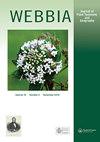Systematic studies on some West African species of the Tribe Bauhinieae (Cercidioideae)
Q3 Agricultural and Biological Sciences
引用次数: 0
Abstract
The tribe Bauhinieae is the largest and most taxonomically complex group within the subfamily Cercidoideae. They possess the most distinguishable morphological features but are the most variable group. Here, we explore the phylogenetic relationship of the tribe Bauhinieae using morphological, anatomical and molecular data (ITS, rbcL, trnL-F, ITS+rbcL+trnL-F). Relationships inferred from morphological, anatomical and molecular data revealed congruent result, a non-monophyletic Bauhinia and Piliostigma group. The leaf epidermal shape in all Bauhinia species examined are polygonal with straight cell walls except B. tomentosa, which has an undulating cell wall. Stomatal types observed vary between the two genera studied. Bauhinia species has paracytic stomata while Piliostigma species exhibited hemiparacytic stomata. Dendrogram generated revealed the interrelationship between the species at a distance value of 80. Bayesian analysis revealed a high resolution of species and posterior probability. The strict consensus tree for all the tested gene regions revealed a polyphyletic Bauhina divided into three major clades. The Piliostigma group exhibited a paraphyletic and polyphyletic relationship within the Bauhinia group at high support values. B tomentosa exhibited a closer relationship with Piliostigma species. These results support the proposition to divide members of the large Bauhinia s.s group into subclades. This study has attempted to elucidate the unresolved species and genus level taxonomy of the tribe Bauhinieae. However, more variable gene regions in addition to broader species sampling should be considered for further phylogenetic patterns of this taxon.西非一些紫荆科植物的系统研究
紫荆科是紫荆亚科中最大、分类学最复杂的类群。它们具有最明显的形态特征,但也是最多变的群体。本文利用形态学、解剖学和分子生物学的数据(ITS、rbcL、trnL-F、ITS+rbcL+trnL-F)对紫荆科部落的系统发育关系进行了探讨。从形态、解剖和分子数据推断出的关系表明,紫荆属和毛柱头属属于非单系。除毛毛紫荆外,所有紫荆属植物的叶表皮均为多边形,细胞壁为直型。观察到的气孔类型在研究的两属之间有所不同。紫荆属植物为全闭合气孔,毛柱头属植物为半闭合气孔。生成的树状图在距离值为80处显示了种间的相互关系。贝叶斯分析显示了物种和后验概率的高分辨率。所有测试基因区域的严格共识树显示,紫荆花多种性分为三个主要分支。毛柱头组在紫荆花组内表现出高支持值的副系和多系关系。毛毛菌与毛柱头种亲缘关系较近。这些结果支持将大紫荆花类群的成员划分为亚支系的主张。本研究试图阐明族紫荆科未解决的种属级分类问题。然而,对于该分类单元的进一步系统发育模式,除了更广泛的物种样本外,还应考虑更多可变的基因区域。
本文章由计算机程序翻译,如有差异,请以英文原文为准。
求助全文
约1分钟内获得全文
求助全文

 求助内容:
求助内容: 应助结果提醒方式:
应助结果提醒方式:


